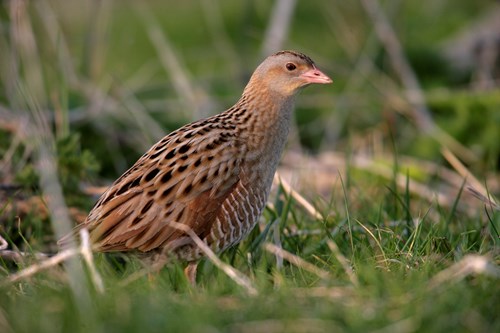Increase in Skye’s corncrake numbers bucks Scotland-wide trend

Partnership work is key to the increase in the number of corncrakes on Skye.
An annual survey of corncrakes in Scotland recorded an increase in the number of calling males on Skye - despite a three per cent reduction overall in Scotland.
RSPB Scotland’s annual survey of corncrakes recorded 14 calling males in Skye in 2022, a slight increase from the ten recorded in 2021.
However, overall in Scotland only 824 calling males were recorded in 2022 compared to 850 in 2021, reflecting the ongoing challenges the species is facing. While this three percent decline is smaller than some of the previous recent year on year reductions, it is a continuation of a downward trend since the record high of 1289 males in 2014.
The results highlight the importance of work being done by the Skye Crofting and Corncrake Partnership (SCCP), involving SAC Consulting - part of SRUC, RSPB Scotland, NFU Scotland and the Scottish Crofting Federation to help local farmers and crofters manage their land to improve Skye’s corncrake population.
The SCCP is key to helping crofters and farmers access support from the RSPB Scotland-led Corncrake Calling project, supported by the National Lottery Heritage Fund – thanks to players of the National Lottery, and the Scottish Government’s Agri-Environment-Climate Scheme (AECS).
Corncrakes are counted across 16 areas in Scotland, with surveyors listening out for the distinctive ‘crex crex’ call of the male birds. With so few corncrakes in the country, Skye’s population is vitally important.
Practical methods used on ‘high nature value’ landscapes to benefit the species include delayed mowing, corncrake-friendly mowing and leaving uncut areas of grassland on field margins to provide cover for birds; curtailing grazing to preserve areas of tall vegetation in spring and summer to allow birds to nest and raise broods; and establishing clumps of tall plants such as iris, nettles, meadowsweet, cow parsley or hogweed.
Janette Sutherland, Agricultural Consultant with SAC Consulting who facilitates the SCCP, said: “The support to crofters and farmers through agri-environment schemes over the past 25 years has been key to the survival of the UK corncrake population and it is critical that we maintain and build on this hard work.
“The corncrake population in Skye is instrumental in expanding its geographical range to mainland areas such as Lochalsh and Glenelg so this small increase in numbers is a positive sign. With such a small population, working in partnership is vitally important to their future survival.”
Chris Bailey, RSPB Scotland’s Advisory Manager, said: “We’re at a crucial point for helping the species and it’s vital that the farmers and crofters whose land they depend on are supported properly.
“The Scottish Government has the ambition to be a global leader in sustainable and regenerative agriculture. It is currently consulting on proposals that will shape how farm funding is spent in future and intends to introduce new legislation to make this possible.
“Since a new system of farm payments won’t be in place until 2026, the Scottish Government must continue to provide adequate funding in the meantime for the Agri-Environment-Climate Scheme which supports the management of farmland for corncrakes and other wildlife.”
Corncrake Calling builds on the decades of work RSPB Scotland has done with farmers and crofters to help corncrakes by continuing its advisory role and engaging with local corncrake communities and people across the country to learn about these birds and be inspired by their plight to help them.
For more information on Corncrake Calling visit: Corncrake Calling (rspb.org.uk) or to learn more about the work of the SCCP visit: Corncrake & Skye Crofting Partnership Conservation Project - The RSPB
Posted by SRUC on 30/11/2022
